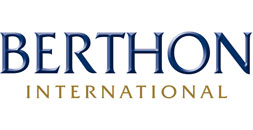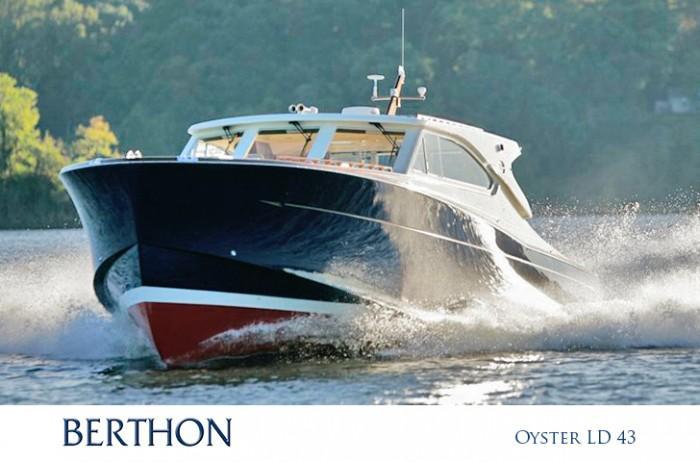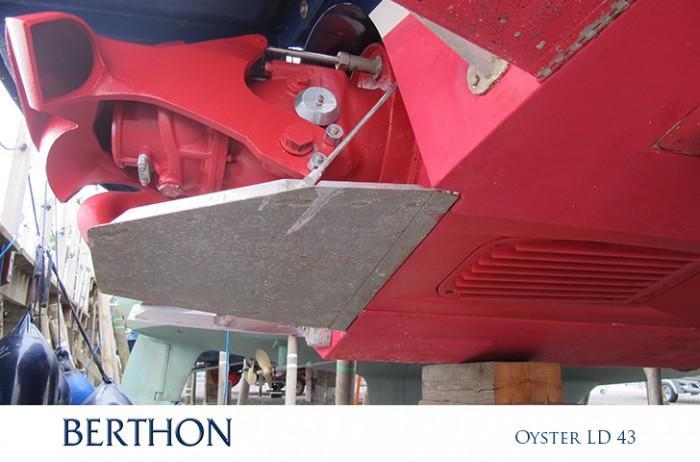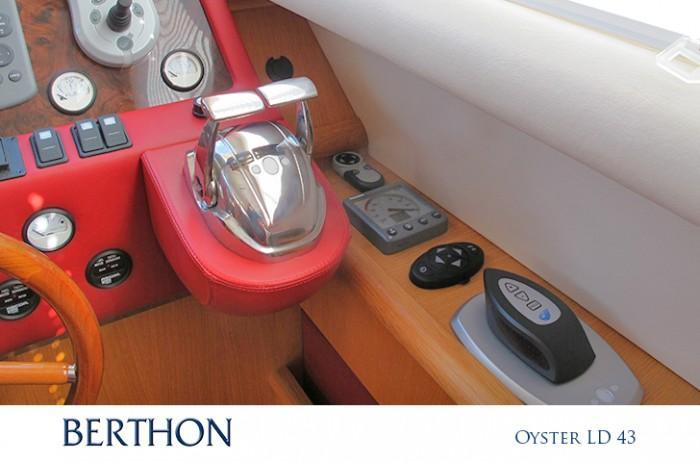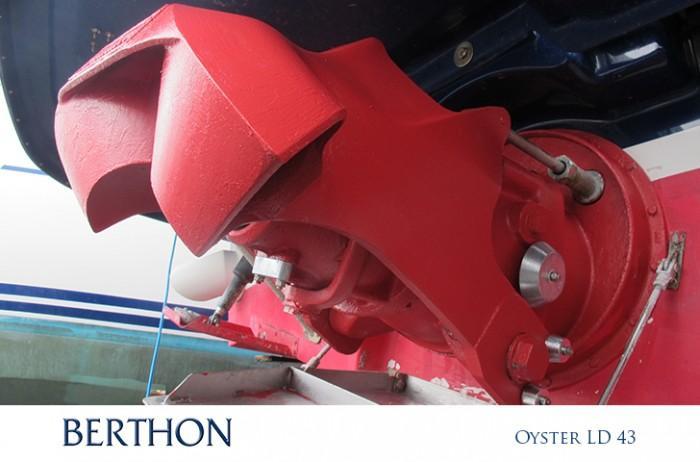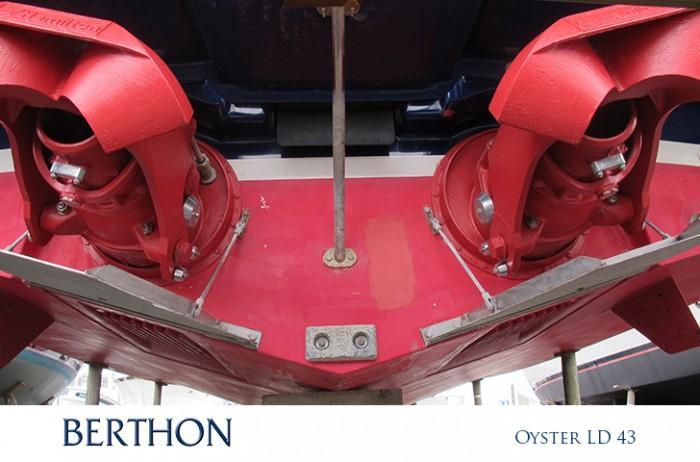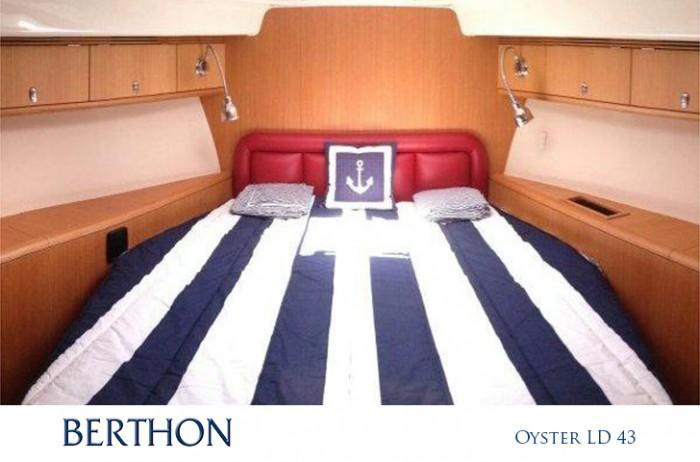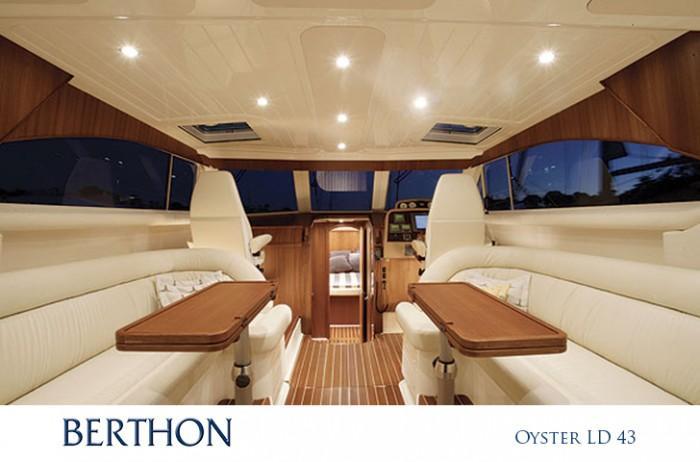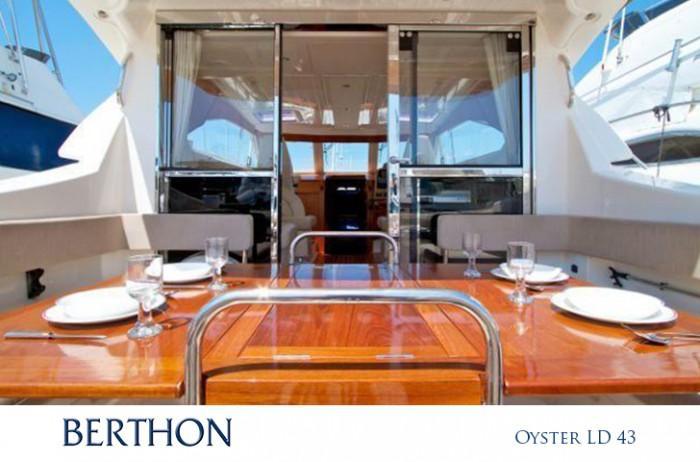Your Local Broker, Internationally
Berthon UK
(Lymington, Hampshire - UK)
Sue Grant
sue.grant@berthon.co.uk
0044 (0)1590 679 222
Berthon Scandinavia
(Henån, Sweden)
Magnus Kullberg
magnus.kullberg@berthonscandinavia.se
0046 304 694 000
Berthon Spain
(Palma de Mallorca, Spain)
Simon Turner
simon.turner@berthoninternational.com
0034 639 701 234
Berthon USA
(Rhode Island, USA)
Jennifer Stewart
jennifer.stewart@berthonusa.com
001 401 846 8404
Lunch and Dinner at 30 knots.
October 30th, 2015
The Oyster LD (lunch and dinner) 43’ is an epic, and much underrated motor yacht. Having been involved with the sale of a few of these now, we felt that this marque merited a few words as they are superb for use both in our waters and in the Mediterranean with their timeless good looks and simple concept.
Many designers and builders try to make their offering do many things; the LD 43 sits unashamedly in this category, and successfully. With jet drives for easy manoeuvring and all the advantages that come with a yacht that can get very close to the beach, an enormous cockpit and great saloon and a single double berth and heads – this is no multi-couple accommodation yacht. Guests are welcome, but should leave after dinner, and the galley majors on a dishwasher, fridge and ice maker rather than a washing machine and acres of stowage.
She is the perfect platform from which her 2 person crew can live, entertain and cruise, but above all, they can live well. Here is the griff:
The story of the jetboat
The early 1950’s was a post-war pressure-cooker for technological advance in the marine industry, with composites becoming prevalent in shipwrighting, and the use of a centrifugal pump to impel, and then expel a stream of water through a steerable nozzle. As waterjet design advanced through the 1970’s, units entered commercial service – offering benefits from extreme shoal draft operation (with commensurate low drag performance), lack of complicated moving components (with most moving parts inboard), precision manoeuvrability at all speeds and complete lack of exposed propellers/blades.
How it works
A conventional engine drives a shaft, which simply spins the impellor(s), drawing water in through a flush-to-hull intake, accelerating the flow to a high velocity stream and expelling it through a nozzle at the transom. Multiple units can be used, and the use of the ducted vent or bucket to direct thrust at desired angles, allows exceptionally precise 360 degree control. So, by diverting the jet by dropping the deflector, or “bucket”, all thrust is sent forward, effectively engaging reverse, and by diverting the jetstreams and manipulating power exceptional close-quarter handling is available. Here at Berthon, we not only work on leisure craft jet installations such as those on the Oyster LD43, but have fitted no less 22 jet systems to the RNLI’s new Shannon Class all-weather lifeboats which we have been building for the last few years – again driven on twin Hamilton HJ364 jets.
How does a jetboat drive?
At the helm station of the LD43 the pilot can select where to apply thrust, control power of flow via the engine(s) and with electronically managed systems such as the blueARROW interface from Hamilton Jet, the yacht can be controlled via convention throttle and wheel, a computerised (and lockable) mouse, and via a toggled back-up joystick. Other systems use separate “bucket” and throttle controls – largely dependent on the desired application of the vessel in question. Since the power is flowing around the transom area (without rudders) slow speed handling takes a while to grow accustomed to, as the stern is steering the bow – but this is quickly learned.
For an example of how versatile and manoeuvrable jets can be, here is Ollie Philips trialling a Shannon!
Servicing jets
The majority of manufacturers use hydraulics to steer and control “bucket” position – so hydraulic pump servicing is required; a number of anodes, due the metallic content of the drive gears will also need replacing. Other than this, the number moving parts are relatively few, so periodic inspections for wear and cleanliness is required, since a cleaner impeller means a faster jet!
Jets and the LD (Lunch and Dinner) 43 story
Oyster Marine’s historical involvement in the building of quality, blue-water cruising yachts led Owners to approach them to design a motor-yacht of the same inherent sea-keeping ability, with comfortable accommodation and luxurious fit-out. The jet drive system was selected to provide ease of manoeuvring, performance, shoal draft viability and maximum safety. The hull is moulded with carbon and Kevlar composites to high-load areas, with a sharp, cleaving deep-vee profile up forward, flaring to a flatter aft section for maximum efficiency for the jets.
Within this hull, the LD affords a beautifully-crafted double forward cabin (above) with plenty of storage, leading aft into a lower galley area (where the “D” of LD – dinner can be prepared) with a separate head (electric of course), and a walk-in shower stall. The main helm is set to starboard in the main saloon – with a co-pilot station to the port side, and the yacht is very much designed about a couple cruising the boat in comfort and handling her with ease. The supportive helm seats from Norway’s NorSap are as good as a helmsman’s lot gets – easily within reach of all controls, and giving a superb view forward through her three screens over that long, flat, forward deck. Aft are two facing sofas, each with a table, and the party piece of two powered rams to lift both sides for easy access to her twin Yanmar engines.
The bulkhead (photo below) to her aft cockpit has a sliding s/s door system with powered dropping windows and a small stainless steel sill for an airy feel to the interior when needed, or you are out in the open through the doors to her aft seating area. This is the “L” of the LD – lunch!
An immaculately varnished central table (with a refrigerated coolbox, of course, in the centre) is flanked by two handy lockers to swallow deck kit, and provide cosy seating for her guests. Beneath the teak cockpit sole lie the jackshafts which provide the power to the Hamilton jet units, and a neat dropping gate in the transom leads onto the bathing platform. With no exposed stern gear, the yacht can be backed up into shallow water, and of course there are no propellers to get caught on – so she is a superlative “beach yacht”.
Under way, she has very precise steering; but since she has no keel or rudders to speak of, she is prone to wander at lower speeds. Once easily away from the dock, with power applied she will cruise around the lower twenties – again with very precise control (remember that all of her steering is actually done behind her wetted transom), and top out with a clean bottom, flattish water and a light load, at just under the 30 knot mark – so she canters along at a steady clip. The hull always feels hugely within itself, and is stiff, constant and actually remarkably dry once at speed. For us – the single most interesting facet is the close-quarter manoeuvring that the jets afford, allowing flexibility that simply cannot be achieved with a conventional propeller drive arrangement.
The LD43’s rakish good-looks hark back to the plumb-bowed Downeaster-styled motor-yachts still gracing Florida, with a handsome tumble-home to set off her Navy hull, and a purposeful gait under way. When ashore in our yard, they are one of the most enquired-about offerings we have, and with recent sales, and another currently proceeding, there has never been a better time to explore these jet-powered Crustacea and have lunch and dinner at 30 knots.
Shown below are the LD 43s that Berthon currently has available in brokerage captivity
Oyster LD43 – JOLLY GOOD [OFF MARKET]
Contact hugh.rayner@berthon.co.uk.
